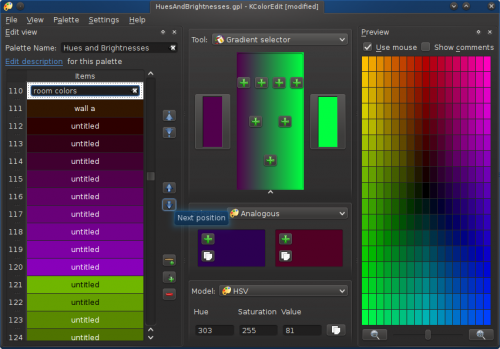KColorEdit/en: Difference between revisions
(Updating to match new version of source page) |
(Updating to match new version of source page) |
||
| Line 21: | Line 21: | ||
* Supports comments | * Supports comments | ||
* Supports description and name of the | * Supports description and name of the palette | ||
| Line 49: | Line 49: | ||
== Working with KColorEdit == | == Working with KColorEdit == | ||
KColorEdit is intended be a tool for web designers, is particulary useful when editing CSS files and you want to choose the "right" color for your | '''KColorEdit''' is intended be a tool for web designers, is particulary useful when editing CSS files and you want to choose the "right" color for your project. | ||
=== Making pages for Visual Health === | === Making pages for Visual Health === | ||
Many pages have a nice design, but sometimes those pages has issues with the color scheme. For example: when you try to read the text you can't do it | Many pages have a nice design, but sometimes those pages has issues with the color scheme. For example: when you try to read the text you can't do it because of the background. Indeed, when the text color's and background color's doesn't contrast themselves (or doesn't fit) then the eye has to be extra effort to read the text. | ||
Image you have #fe9f10 as background color. Lets add this color to our palette (click the {{plus}} button). | |||
[[Image:7-kcoloredit-usecase-contrast-step1.png|center|350px|thumb]] | [[Image:7-kcoloredit-usecase-contrast-step1.png|center|350px|thumb]] | ||
With KColorEdit is easy to select the "oposite" color: the (best) text color. Just | With '''KColorEdit''' is easy to select the "oposite" color: the (best) text color. Just select <menuchoice>Complement</menuchoice> in the <menuchoice>Sheme</menuchoice> drop down list and the task is done. | ||
| Line 73: | Line 72: | ||
KColorEdit is part of KDE Extragear. The [http://docs.kde.org/development/en/extragear-graphics/kcoloredit/index.html User Handbook] is fairly old, but helpful. | '''KColorEdit''' is part of KDE Extragear. The [http://docs.kde.org/development/en/extragear-graphics/kcoloredit/index.html User Handbook] is fairly old, but helpful. | ||
[[Category:Graphics]] | [[Category:Graphics]] | ||
Revision as of 08:25, 3 September 2012
 |
KColorEdit is a very usefull tool for easy and fun editing and creation of color palettes. |
General Features
- KDE and GTK color selectors
- Full support of GIMP palette standard (see GIMP palettes)
- Choice of detail view and brief view of the color palette

- Supports comments
- Supports description and name of the palette

- Colors or comments can be moved to any position inside the palette
- Can be used to generate color schemes (complement color, triadic colors, etc)
- Or generate a random color

- Supports mixing of colors
- Has a gradient selector for color
- Supports increase or decrease of hue and saturation.

Working with KColorEdit
KColorEdit is intended be a tool for web designers, is particulary useful when editing CSS files and you want to choose the "right" color for your project.
Making pages for Visual Health
Many pages have a nice design, but sometimes those pages has issues with the color scheme. For example: when you try to read the text you can't do it because of the background. Indeed, when the text color's and background color's doesn't contrast themselves (or doesn't fit) then the eye has to be extra effort to read the text.
Image you have #fe9f10 as background color. Lets add this color to our palette (click the ![]() button).
button).

With KColorEdit is easy to select the "oposite" color: the (best) text color. Just select in the drop down list and the task is done.

Later, you can add the text color to the palette and copy it to the clipboard: #106ffe

KColorEdit is part of KDE Extragear. The User Handbook is fairly old, but helpful.
